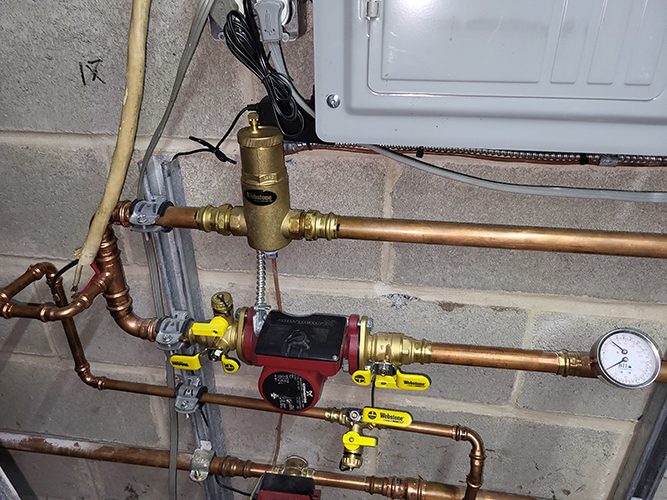New Snowmelt System, Existing Boiler
With high real estate prices, more people are adding premium features, such as snowmelt, to their homes instead of moving.

Last month we discussed snowmelt systems and how keeping them top-of-mind during the summer can be profitable (https://bit.ly/3NhQDdZ). That’s when landscaping work takes place and when many of us have time to service and install them.
This month, I’d like to cover the art of tying a snowmelt system into an existing hydronic system.
With real estate prices going through the roof, more people are adding premium features, such as snowmelt, to their homes instead of moving.
After all, if older homeowners want to stay in their homes instead of moving to a 55-and-over community, but snow removal and winter slip-and-fall hazards have them consulting a realtor, there’s an alternative. Hydronics can eliminate both of those risks.
When determining how and if a snowmelt system can be added to an existing hydronic system, the No. 1 consideration is whether the existing boiler can support it. It will depend on the size of the proposed snowmelt system and the size of the existing boiler.
If the property doesn’t possess enough boiler capacity, you could tie a supplemental boiler into the main loop of the hydronic system or install a dedicated boiler for the snowmelt system. Consider that it takes 30 to 50 BTUs/square foot of surface area if the system is properly installed.
Installing a dedicated boiler eliminates several pitfalls and carries a higher cost. However, I’d like to talk about tying snowmelt into an existing system because it’s where we find the most mistakes in the field.
Modulating or Condensing Boilers
There are a few scenarios where you could find yourself adding a snowmelt system to a boiler intended primarily for space heating. Maybe the project is new construction and you’re designing the system from the ground up. Maybe the boiler was sized to handle a later addition of some sort. Or maybe the boiler is just good, old-fashioned oversized.
The first thing to look at after capacity is whether the boiler is a modulating or conventional unit. If it’s conventional, we’ll need to avoid returning water to the boiler below 130 degrees or risk cracking the boiler or creating condensate in the flue. Keep in mind that oil boilers are generally even more sensitive to low water temperatures than conventional gas models.
On the other hand, if it’s a condensing boiler, there’s no reason to be concerned about return water temperatures. The speed at which water moves through the heat exchanger (more on that later) will determine the temperature of the boiler return water.
The next thing to look at is how the system is piped. Is it primary/secondary piping or some sort of series loop? If it’s not primary/secondary, this may be a good time to make it primary/secondary. We’re going to be adding a heat exchanger for the snowmelt zone, which will change the flow rate, potentially altering how an older hydronic system heats the house.
Heat Exchanger Tips
We prefer to use a Bowman shell-and-tube heat exchanger between the existing hydronic heating system and the new snowmelt system. It’s critical to isolate the snowmelt system from the home heating loop because the snowmelt system requires glycol.
Filling the whole house system with glycol is not advised for three reasons: it is mildly corrosive, a glycol/water mixture carries fewer BTUs per gallon than straight water, and it is more viscous than water, meaning it’s harder to pump.
The heat exchanger is — and will act exactly like — a new zone for the existing boiler. It should have its own zone valve or zone pump, depending on personal preference, the pressure drop of the heat exchanger and the capability of the existing system pump.
By installing a heat exchanger, you have effectively created an entirely new hydronic system. Think about that heat exchanger as a boiler. It’s the heat source for everything on the load side. That means the snowmelt system needs its own pressure-release valve, expansion tank, air elimination and a source of makeup water.
We certainly don’t expect a leak in the snowmelt system, but we can’t provide pure water for makeup. In the event of a slow leak, filling the system with pure water would dilute the glycol mixture in the tubing and reduce its level of freeze protection.
Instead, the same glycol mixture used to fill the system should be provided in an automatic glycol feeder. We’ve used both Axiom and NeutraSafe glycol feeders with good results.
When selecting a pump to circulate the fluid within the snowmelt system, consider the ratio of glycol and water you’ve selected. As previously mentioned, glycol is more viscous than water, so a glycol mixture will create more pumping resistance than water alone.
Most glycol manufacturers list two factors on their product: freeze protection and burst protection. Freeze protection is the ratio of glycol needed at a specific temperature to prevent the fluid from crystalizing and turning to slush. Burst protection is the ratio needed to keep the fluid from freezing solid and bursting PEX.
We use a mixture that provides freeze protection because the controls offer an “exercise” feature that runs the snowmelt pump periodically during the winter.
Control strategies
The next thing to consider is the control strategy. We use tekmar controls on our snowmelt systems exclusively because it offers a wide variety of control systems specifically tailored to snowmelt applications.
The simplest automatic method of controlling a small snowmelt system is via a slab sensor. The sensor is embedded in the surface being melted. If the sensor becomes wet while the outdoor temperature is at, below or near freezing, the system will come on.
Other options range from manual on/off operation to systems that respond to web-enabled weather forecast inputs.
Another consideration is how to control the water temperature. Snowmelting is a marathon, not a sprint. A slab cannot be heated up too quickly or the surface can be “shocked.” Damage can occur to the surface, either in the form of flaking or stress fractures. The way to avoid this is by manipulating supply water temperatures.
On small snowmelt systems (500 square feet and under), we prefer to use a premanufactured mixing block. We’ve used Viega and Taco mixing blocks in the past, though others are on the market. On larger snowmelt systems, we use a snowmelt controller with a separate injection pump.
Finally, pressure-test the system with air and water before the tubing is covered. Once the system is in operation and the snow flies, be sure to call the customer and ask about its performance. Make sure they understand that snow may take a little while to melt, but also ask if there are any differences in the way the home heats.
It’s unlikely, but because you have tied a new, substantial zone into the existing boiler system, some small changes may be needed in the mechanical room. l
Tom Soukup is the principal of Patriot Water Works with more than 20 years as a hydronic designer and installer. He specializes in high-efficiency and green technology and brings his expertise to custom commercial work, pool heating and agricultural projects. Reach Tom at twsoukup@patriotwaterworks.com.





